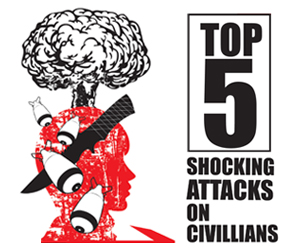
 hill of chemical waste beside Farmer Wu Shuliang’s rice paddy began to take shape in the 1990s. The waste was from a neighboring factory; a byproduct from making chemicals used for tanning leather. Each day for 20 years, workers dumped more of it, making the hill bigger and bigger. Last year, an estimated 300 million pounds of chemical sludge towered over Wu’s land and the river below. “Whenever it rained, our rice paddy and the river would suddenly turn bright yellow,” Wu says. “Much of my rice died. It killed everything in its path.” Around the time the hill began to form, Wu and his wife had two sons. The two boys grew up bathing in the river that turned yellow when it rained. They breathed the dust that blew off of the hill on windy days, and the oldest son, Wu Wenyong, spent much of his childhood working the rice paddies in the hill’s shadow. When he was 14, Wu Wenyong began having health problems. He couldn’t stop coughing; he had difficulty breathing, and his chest hurt. “We heard on the local news that this hill might be harmful to our health, so we took our son to the hospital and asked the doctor whether it had anything to do with his health problems,” remembers Wu’s mother Qi Xianying. “The doctor didn’t say anything. He just shook his head.” Wu Wenyong was in eighth grade when he was diagnosed with two types of cancer: leukemia and thymoma. At the time, the environmental NGO Greenpeace had traveled to Wu’s village here in rural Yunnan province to test the water in the rice paddies and wells surrounding the hill. The samples were high in Chromium-6, a known carcinogen. One water sample from Wu’s land showed the level of Chromium-6 was 240 times higher than what China and the U.S. allows in their drinking water. Officials are worried, because villages like these supply China with its food. Five years ago, a soil survey taken from rice in three of China’s largest agricultural provinces shocked Chinese consumers. Sixty percent of the rice samples showed excessive amounts of cadmium, a heavy metal that causes bone and kidney damage. At the time, Chinese scientists openly discussed the widespread contamination of China’s food supply. But these days, they’re not talking. Several scientists declined interviews with Marketplace. That’s because late last year, China’s communist party declared national soil surveys ‘state secrets.’ Revealing China’s ‘state secrets’ can send you to prison. American scientist Peter Green says in the case of Chromium-6, which polluted the soil in Xinglong Village, it’s undoubtedly been absorbed by the rice grown there. “Rice, like all plants, takes up water from its roots,” Green says, “and Chromium-6 — hexavalent chromium — is very soluble in water, and will get into the plants. And that’s unfortunate, because it can get into the food chain and be eaten by humans or perhaps other animals.” Back in Xinglong village, the 300-million-pound hill of Chromium-6 waste is now gone. The company that created it, LuLiang Peace Technology, removed the waste a few months ago. But farmer Wu Shuliang says his well water is still contaminated, and they still grow rice in the yellow contaminated water they pump from their well. Their family doesn’t dare eat it. Instead, they sell it to others. “We don’t have a choice,” says Qi. “We lost all our money paying the medical bills for our son. Now he’s dead, and we’re broke. We know the rice is dangerous. We sell it to vendors from other provinces in China who travel here to purchase it.”
hill of chemical waste beside Farmer Wu Shuliang’s rice paddy began to take shape in the 1990s. The waste was from a neighboring factory; a byproduct from making chemicals used for tanning leather. Each day for 20 years, workers dumped more of it, making the hill bigger and bigger. Last year, an estimated 300 million pounds of chemical sludge towered over Wu’s land and the river below. “Whenever it rained, our rice paddy and the river would suddenly turn bright yellow,” Wu says. “Much of my rice died. It killed everything in its path.” Around the time the hill began to form, Wu and his wife had two sons. The two boys grew up bathing in the river that turned yellow when it rained. They breathed the dust that blew off of the hill on windy days, and the oldest son, Wu Wenyong, spent much of his childhood working the rice paddies in the hill’s shadow. When he was 14, Wu Wenyong began having health problems. He couldn’t stop coughing; he had difficulty breathing, and his chest hurt. “We heard on the local news that this hill might be harmful to our health, so we took our son to the hospital and asked the doctor whether it had anything to do with his health problems,” remembers Wu’s mother Qi Xianying. “The doctor didn’t say anything. He just shook his head.” Wu Wenyong was in eighth grade when he was diagnosed with two types of cancer: leukemia and thymoma. At the time, the environmental NGO Greenpeace had traveled to Wu’s village here in rural Yunnan province to test the water in the rice paddies and wells surrounding the hill. The samples were high in Chromium-6, a known carcinogen. One water sample from Wu’s land showed the level of Chromium-6 was 240 times higher than what China and the U.S. allows in their drinking water. Officials are worried, because villages like these supply China with its food. Five years ago, a soil survey taken from rice in three of China’s largest agricultural provinces shocked Chinese consumers. Sixty percent of the rice samples showed excessive amounts of cadmium, a heavy metal that causes bone and kidney damage. At the time, Chinese scientists openly discussed the widespread contamination of China’s food supply. But these days, they’re not talking. Several scientists declined interviews with Marketplace. That’s because late last year, China’s communist party declared national soil surveys ‘state secrets.’ Revealing China’s ‘state secrets’ can send you to prison. American scientist Peter Green says in the case of Chromium-6, which polluted the soil in Xinglong Village, it’s undoubtedly been absorbed by the rice grown there. “Rice, like all plants, takes up water from its roots,” Green says, “and Chromium-6 — hexavalent chromium — is very soluble in water, and will get into the plants. And that’s unfortunate, because it can get into the food chain and be eaten by humans or perhaps other animals.” Back in Xinglong village, the 300-million-pound hill of Chromium-6 waste is now gone. The company that created it, LuLiang Peace Technology, removed the waste a few months ago. But farmer Wu Shuliang says his well water is still contaminated, and they still grow rice in the yellow contaminated water they pump from their well. Their family doesn’t dare eat it. Instead, they sell it to others. “We don’t have a choice,” says Qi. “We lost all our money paying the medical bills for our son. Now he’s dead, and we’re broke. We know the rice is dangerous. We sell it to vendors from other provinces in China who travel here to purchase it.”
(Source: Abstracted from Marketplace)
Be environmental friendly:
![]()
Read also:























